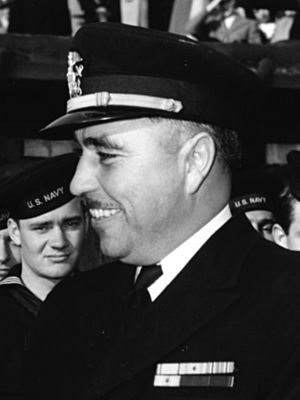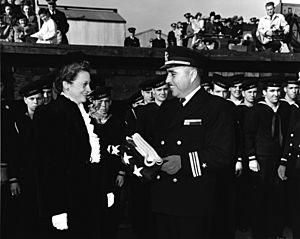Ernest E. Evans facts for kids
Quick facts for kids
Ernest Edwin Evans
|
|
|---|---|

Evans in 1943
|
|
| Nickname(s) | "Big Chief" |
| Born | August 13, 1908 Pawnee, Oklahoma |
| Died | October 25, 1944 (aged 36) off Samar, Philippine Islands |
| Place of burial |
remains not recovered; listed on the Walls of the Missing, Manila American Cemetery
|
| Allegiance | United States |
| Service/ |
United States Navy |
| Years of service | 1931–1944 |
| Rank | Commander |
| Commands held | USS Alden USS Johnston |
| Battles/wars | World War II
|
| Awards | Medal of Honor Bronze Star Philippine Liberation Medal |
Ernest Edwin Evans (born August 13, 1908 – died October 25, 1944) was a brave officer in the United States Navy. He was given the Medal of Honor after he died for his amazing actions during the Battle off Samar in World War II.
Contents
Evans was part Native American, with half Cherokee and one quarter Creek heritage. He was born in Pawnee, Oklahoma. After high school, he joined the Navy for a year. Then, he was accepted into the United States Naval Academy in 1927 and graduated in 1931.
In 1941, he was assigned to the destroyer Alden. He was on this ship in the East Indies when Japan attacked Pearl Harbor in December 1941. He became the commander of the Alden in March 1942 and served there until July 1943. During this time, he helped with operations around Australia, New Guinea, and the Dutch East Indies.
In mid-1943, Evans was given the job of getting the Fletcher-class destroyer Johnston ready for service. This happened at the Seattle-Tacoma Shipbuilding Corporation in Seattle, Washington. Commander Evans took command of the Johnston when it was officially put into service on October 27, 1943. He told his crew, "This is going to be a fighting ship. I intend to go in harm's way, and anyone who doesn't want to go along had better get off right now." He later received the Bronze Star for sinking the Japanese submarine I-176 on May 16, 1944.
Heroic Actions in Battle
The Battle off Samar was a major part of the larger Battle of Leyte Gulf. In this battle, Commander Evans led the Johnston until it was sunk on October 25, 1944. They faced a Japanese force that was much bigger and had far more powerful ships and weapons.
The Johnston, along with two other destroyers (Hoel and Heermann), four smaller destroyer escorts, and six escort aircraft carriers, formed a group called Taffy 3. This group, along with planes from another group called Taffy 2, managed to stop a large Japanese fleet. This Japanese fleet included 4 battleships, 6 heavy cruisers, 2 light cruisers, and 11 destroyers. Their mission was to attack the landing beaches at Leyte, where General Douglas MacArthur's troops were. But Taffy 3 forced them to turn back. This famous battle is often called "The Last Stand of the Tin Can Sailors".
When the Japanese fleet was first seen, Commander Evans acted quickly. He ordered his ship to create a smoke screen to help hide the smaller escort carriers from enemy fire. Then, he bravely steered his destroyer away from his group and charged alone towards the enemy to launch a torpedo attack.
Some people say Evans told his crew over the ship's speaker: "A large Japanese fleet has been contacted. They are fifteen miles away and headed in our direction. They are believed to have four battleships, eight cruisers, and a number of destroyers. This will be a fight against overwhelming odds from which survival cannot be expected. We will do what damage we can." However, other reports say the last part of this message was actually said by Lieutenant Commander Robert W. Copeland from Samuel B. Roberts, who also bravely charged into battle with Evans.
What happened to Commander Evans after the Johnston sank is not fully known. He was badly wounded during the battle. He lived long enough to give the order for his crew to abandon ship. But he was not among those who were rescued. Evans was given the Medal of Honor after he died for his important role in the big victory at Leyte Gulf. His group also received the Presidential Unit Citation for their bravery in this battle.
Remembering a Hero
In 1955, a destroyer escort called USS Evans (DE-1023) was named in his honor. This ship was taken out of service in 1968. Today, no active ship carries the name Evans or Johnston. However, some active ships are named after the Samuel B. Roberts and its crew. In 2013, people started a petition to name a new ship after Evans.
On May 23, 2013, a special virtual simulator at the Naval Station Newport in Newport, Rhode Island was named the Evans Full Mission-2 Simulator. This simulator helps train Navy officers in shiphandling and honors Commander Evans.
Awards and Honors
| Medal of Honor | Bronze Star Medal | Purple Heart |
| Presidential Unit Citation | American Defense Service Medal | American Campaign Medal |
| Asiatic-Pacific Campaign Medal | World War II Victory Medal | Philippine Liberation Medal |
See also
 In Spanish: Ernest E. Evans para niños
In Spanish: Ernest E. Evans para niños


